
Swedish cuisine is the traditional food of Sweden. Due to Sweden's large north-to-south expanse, there are regional differences between the cuisine of North and South Sweden.

Turkish cuisine is the cuisine of Turkey and the Turkish diaspora. Although the cuisine took its current rich form after numerous cultural interactions throughout centuries, it should not be confused with other cuisines such as Ottoman cuisine or Seljuk cuisine. Turkish cuisine with traditional Turkic elements such as yogurt, ayran, kaymak, exerts and gains influences to and from Mediterranean, Balkan, Middle Eastern, Central Asian and Eastern European cuisines.

Lutefisk is dried whitefish, usually cod, but sometimes ling or burbot, cured in lye. It is made from aged stockfish, or dried and salted cod. The fish takes a gelatinous texture after being rehydrated for days prior to eating.

Rutabaga or swede is a root vegetable, a form of Brassica napus. Other names include Swedish turnip, neep (Scots), and turnip. However, elsewhere, the name "turnip" usually refers to the related white turnip. The species Brassica napus originated as a hybrid between the cabbage and the turnip. Rutabaga roots are eaten as human food in various ways, and the leaves can be eaten as a leaf vegetable. The roots and tops are also used for livestock, fed directly in the winter or foraged in the field during the other seasons. Scotland, Northern and Western England, Wales, the Isle of Man, and Ireland had a tradition of carving the roots into Jack-o'-lanterns at Halloween.

Tripe is a type of edible lining from the stomachs of various farm animals. Most tripe is from cattle, pigs and sheep.

Lamb, hogget, and mutton, generically sheep meat, are the meat of domestic sheep, Ovis aries. A sheep in its first year is a lamb and its meat is also lamb. The meat from sheep in their second year is hogget. Older sheep meat is mutton. Generally, "hogget" and "sheep meat" are not used by consumers outside Norway, New Zealand, South Africa, Scotland, and Australia. Hogget has become more common in England, particularly in the North often in association with rare breed and organic farming.

Offal, also called variety meats, pluck or organ meats, is the internal organs of a butchered animal. The word does not refer to a particular list of edible organs, and these lists of organs vary with culture and region, but usually exclude skeletal muscle. Offal may also refer to the by-products of milled grains, such as corn or wheat.
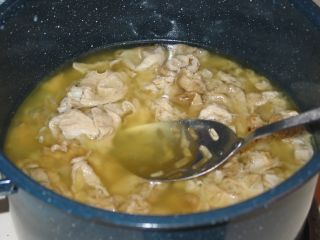
Chitterlings, sometimes spelled chitlins or chittlins, are the small intestines of domestic animals. They are usually made from pigs' intestines. They may also be filled with a forcemeat to make sausage. Intestine from other animals, such as beef, lamb, goose, and goat is also used for making chitterling.
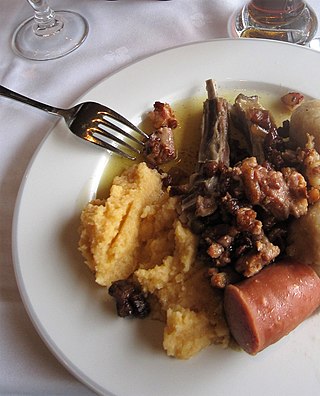
Pinnekjøtt is a traditional Norwegian main course dinner dish based on lamb ribs. Pinnekjøtt is a festive dish typical to Western and Northern Norway, and is rapidly gaining popularity in other regions as well. This dish is largely associated with the celebration of Christmas and frequently paired with puréed rutabaga, sausages and potatoes, served with beer and akevitt.

South African cuisine reflects the diverse range of culinary traditions embodied by the various communities that inhabit the country. Among the indigenous peoples of South Africa, the Khoisan foraged over 300 species of edible food plants, such as the rooibos shrub legume, whose culinary value continues to exert a salient influence on South African cuisine. Subsequent encounters with Bantu pastoralists facilitated the emergence of cultivated crops and domestic cattle, which supplemented traditional Khoisan techniques of meat preservation. In addition, Bantu-speaking communities forged an extensive repertoire of culinary ingredients and dishes, many of which are still consumed today in traditional settlements and urban entrepôts alike.
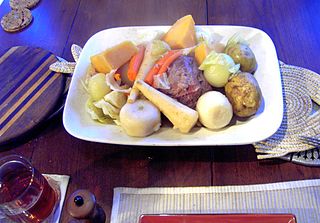
A New England boiled dinner is a traditional New England meal, consisting of corned beef with cabbage and one or more root vegetables, such as potatoes, rutabagas, parsnips, carrots, turnips, or onions. The leftovers are traditionally diced and fried into “red flannel hash” for breakfast the next day. The dish resembles boiled beef from English cuisine, as well as a similar Newfoundland dish called a "Jiggs dinner".
Norwegian cuisine in its traditional form is based largely on the raw materials readily available in Norway and its mountains, wilderness, and coast. It differs in many respects from continental cuisine through the stronger focus on game and fish. Many of the traditional dishes are the result of using conserved materials, necessary because of the long winters.

Khash is a dish of boiled cow or sheep parts, which might include the head, feet, and stomach (tripe). It is a dish of Armenian origin.
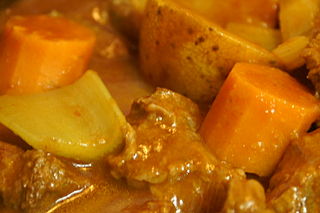
Lobscouse is a thick Scandinavian stew made of meat and potatoes.
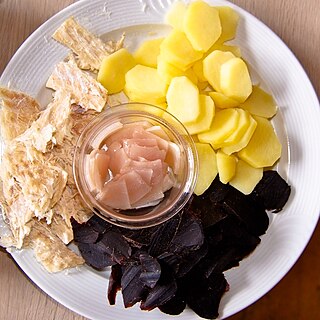
Tvøst og spik is a typical dish of the Faroe Islands, a self-governing country of Denmark in the North Atlantic. Tvøst og spik consists of pilot whale meat, blubber and potatoes.

Important parts of Faroese cuisine are lamb and also fish owing to proximity to the sea. Traditional foods from the Faroe Islands include skerpikjøt, seafood, whale meat, blubber, garnatálg, Atlantic puffins, potatoes, and few fresh vegetables.

A stew is a combination of solid food ingredients that have been cooked in liquid and served in the resultant gravy. Ingredients can include any combination of vegetables and may include meat, especially tougher meats suitable for slow-cooking, such as beef, pork, venison, rabbit, lamb, poultry, sausages, and seafood. While water can be used as the stew-cooking liquid, stock is also common. A small amount of red wine or other alcohol is sometimes added for flavour. Seasonings and flavourings may also be added. Stews are typically cooked at a relatively low temperature, allowing flavours to mingle.

Fenalår is a traditional Norwegian cured meat made from salted and dried leg of lamb. Fenalår is a very popular dish in Norway and is often served with other preserved food at a Christmas buffet or on Norwegian Constitution Day.


















